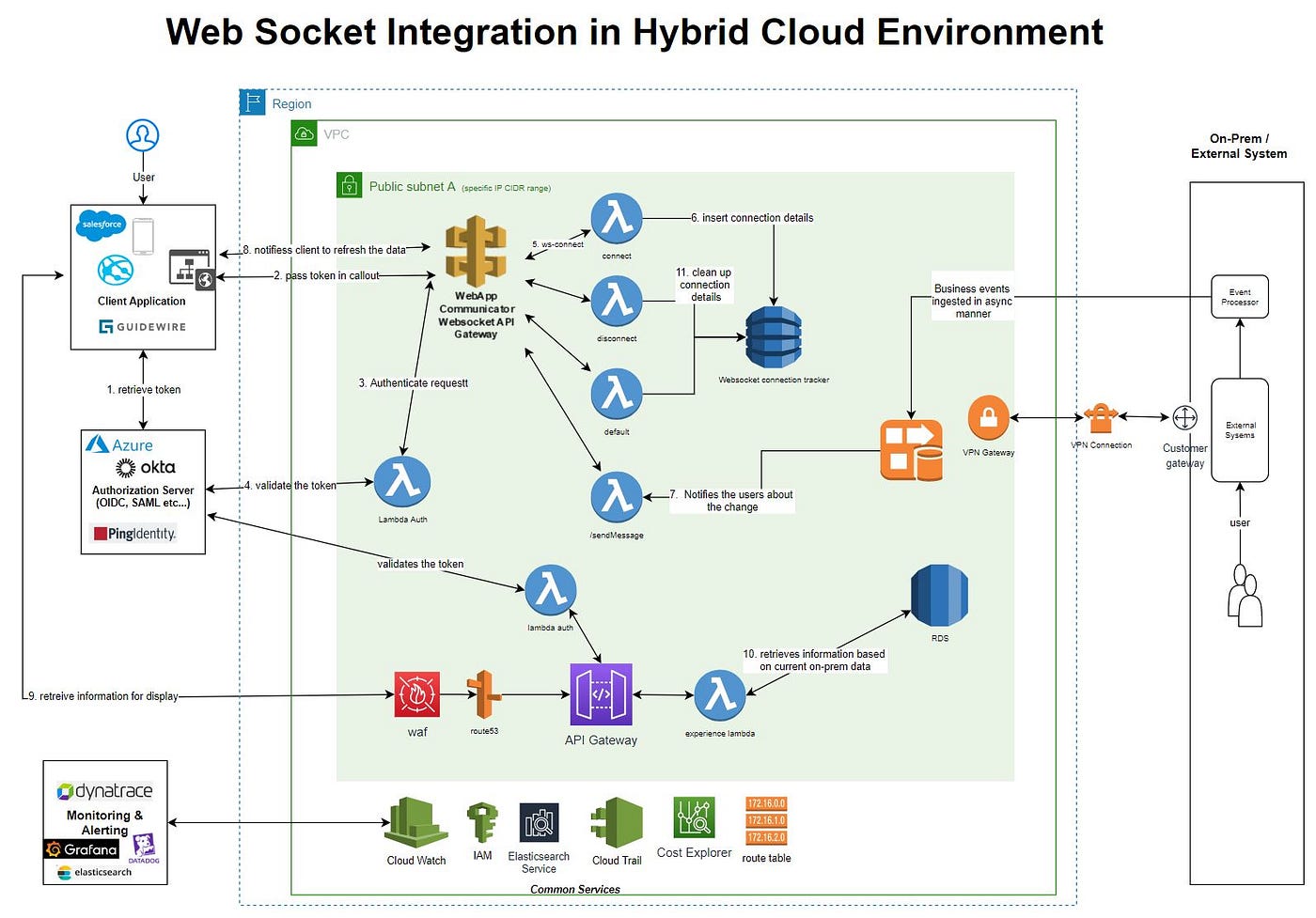WebSocket Protocol is a communication protocol that provides full-duplex communication over a single TCP connection. It allows for real-time data transfer between a client and a server, enabling a more interactive and efficient web experience. Let’s explore what WebSocket Protocol is and why it’s advantageous.
What is WebSocket Protocol?
WebSocket Protocol is designed to overcome the limitations of traditional HTTP requests and responses. Unlike HTTP, which is request-based and requires a new connection for every request, WebSocket allows for a persistent connection between the client and the server. This means that the server can push data to the client without the client needing to request it, leading to faster and more efficient communication.
Advantages of Using WebSocket Protocol
WebSocket Protocol offers several advantages over other communication protocols, making it a preferred choice for real-time web applications.
- Bi-directional Communication: Unlike traditional HTTP, WebSocket enables simultaneous and instant communication between the client and the server. This bidirectional flow of data allows for interactive and real-time features in web applications.
- Efficiency: WebSocket uses a single TCP connection, reducing overhead and eliminating the need for repeated connections. This results in faster data transfer and reduced latency.
- Real-time Updates: WebSocket enables real-time updates and notifications, making it ideal for applications that require instant updates, such as chat applications, stock tickers, or collaborative tools.
How Does WebSocket Protocol Work?
WebSocket Protocol follows a handshake process to establish a connection. Here’s an overview of the process:
- Handshake: The client sends an HTTP request to the server, containing a special header that initiates the WebSocket connection.
- Upgrade: If the server supports WebSocket Protocol, it responds with a special response header, indicating a successful upgrade from HTTP to WebSocket.
- Connection Established: Once the connection is established, both the client and the server can send data to each other at any time. The data is transmitted in a structured format, allowing for efficient parsing on both ends.
WebSocket Protocol supports both text and binary data, making it versatile for a wide range of applications.
In conclusion, WebSocket Protocol is a powerful communication protocol for real-time web applications. Its advantages include bi-directional communication, efficiency, and real-time updates. By utilizing WebSocket Protocol, web applications can provide a more interactive and dynamic user experience.

WebSocket Protocol Features
Real-time Communication
WebSocket protocol is a communication protocol that allows for real-time, bidirectional communication between a client and a server. Unlike traditional HTTP, which follows a request-response model, WebSocket enables constant communication between the client and server, making it ideal for applications that require instant updates, such as chat applications, stock tickers, and collaborative tools. With WebSocket, information can be pushed from the server to the client in real-time, eliminating the need for the client to continuously send requests for updates.
Full-duplex Communication
WebSocket provides full-duplex communication, allowing both the client and the server to send and receive messages simultaneously. In other words, data can be sent in both directions at the same time, without the need to wait for a response before sending the next message. This feature allows for more efficient and seamless communication between the client and server, resulting in a smoother user experience.
Low Latency and Overhead
WebSocket protocol minimizes latency and reduces unnecessary overhead compared to traditional HTTP. Unlike HTTP, which requires the establishment of a new connection for each request, WebSocket maintains an open connection throughout the session, reducing the overhead of establishing and tearing down connections repeatedly. This results in faster communication and reduces network congestion, making WebSocket a suitable choice for applications that require real-time updates and low-latency communication.
WebSocket uses a single connection over a persistent TCP connection, eliminating the need for multiple HTTP requests and responses. This enables WebSocket to transmit data more efficiently, reducing network latency and bandwidth usage. By minimizing the amount of data sent back and forth between the client and server, WebSocket helps optimize network performance and improves the overall responsiveness of web applications.
In summary, WebSocket protocol offers real-time, bidirectional communication between the client and server, allowing for instant updates without the need for continuous requests. It provides full-duplex communication, enabling simultaneous data transfer in both directions. Additionally, WebSocket minimizes latency and overhead by using a persistent connection and reducing network congestion. These features make WebSocket an essential protocol for building responsive and efficient web applications.

WebSocket Protocol Implementation
WebSocket Protocol is a communication protocol that provides full-duplex communication channels over a single TCP connection. It allows for interactive communication between a client and a server, enabling real-time data streaming without the need for constant polling.
WebSocket API
The WebSocket API is a set of methods, events, and protocols that facilitate the establishment of a WebSocket connection and the exchange of data between the client and server. The API provides a simple yet powerful way to implement real-time functionality into web applications. It includes methods to open, close, send, and receive messages over a WebSocket connection.
WebSocket Libraries and Frameworks
To make WebSocket implementation easier, there are various libraries and frameworks available. These libraries provide pre-built functions and components that handle the low-level details of the WebSocket protocol, allowing developers to focus on the application logic.
Some popular WebSocket libraries and frameworks include:
- Socket.IO: A JavaScript library that enables real-time, bidirectional communication between clients and servers.
- STOMP: A simple messaging protocol that can be used with RabbitMQ message broker to enable WebSocket communication.
- ws: A lightweight WebSocket implementation for Node.js.
Supported Browsers and Platforms
WebSocket protocol is supported by most modern web browsers, including Google Chrome, Mozilla Firefox, Microsoft Edge, and Safari. It also has support for various platforms, such as desktop computers, mobile devices, and IoT devices. With widespread support, developers can confidently implement WebSocket functionality in their applications without worrying about compatibility issues.
In conclusion, the WebSocket protocol is a powerful solution for real-time communication between clients and servers. With the WebSocket API, developers can easily implement WebSocket functionality in their web applications. Additionally, the availability of WebSocket libraries and frameworks simplifies the implementation process. Thanks to the broad support across browsers and platforms, WebSocket-based applications can reach a wide range of users, delivering a seamless real-time experience.

WebSocket Security and Authentication
Securing WebSocket Connections
WebSocket is a communication protocol that provides full-duplex communication channels over a single TCP connection. While the WebSocket protocol offers many advantages for real-time web applications, it is essential to ensure the security of these connections. Here are some key points to consider when securing WebSocket connections.
1. Transport Layer Security (TLS)
TLS, formerly known as SSL, is a crucial security measure for WebSocket connections. It provides encryption and authentication to ensure that data transmitted between the client and the server remains private and tamper-proof. Implementing TLS certificates and enforcing the use of HTTPS for WebSocket connections significantly enhances security.
2. Access Control and Origin Validation
To prevent unauthorized access, it is vital to implement access control mechanisms and properly validate the origin of requests. Whitelisting and restricting access based on IP addresses or domains can help protect against attacks and ensure that WebSocket connections are only established with trusted sources.
3. Authentication and Authorization
Implementing authentication and authorization mechanisms is essential to ensure that only authorized users can establish WebSocket connections and access sensitive data. This can be achieved through techniques like API keys, OAuth, or session-based authentication. By verifying the identity of clients, you can prevent malicious actors from exploiting WebSocket connections.
4. Rate Limiting and Connection Management
Implementing rate limiting strategies can help protect against attacks and ensure that WebSocket connections are not abused. By setting limits on the number of requests or connections per second, you can prevent denial-of-service attacks and promote fair usage of resources.
5. Handling Data Validation and Sanitization
To prevent security vulnerabilities like injection attacks or cross-site scripting, it is crucial to validate and sanitize all data received from clients before processing or storing it. Implementing proper data validation and sanitization techniques can help mitigate the risks associated with malicious or malformed data.
By taking these security measures, you can ensure the confidentiality, integrity, and availability of WebSocket communication in your web applications. Securing WebSocket connections is crucial to protect sensitive data, prevent unauthorized access, and maintain a robust and reliable communication channel.
Remember to regularly update and patch your WebSocket implementation to stay up-to-date with the latest security standards and best practices.








I’ve been surfing online more than 4 hours today, yet I never found any interesting article
like yours. It’s pretty worth enough for me. In my view, if all web owners and bloggers made
good content as you did, the net will be a lot more useful
than ever before.
Hi Neat post Theres an issue together with your web site in internet explorer may test this IE still is the marketplace chief and a good component of people will pass over your fantastic writing due to this problem
The issue has been resolved